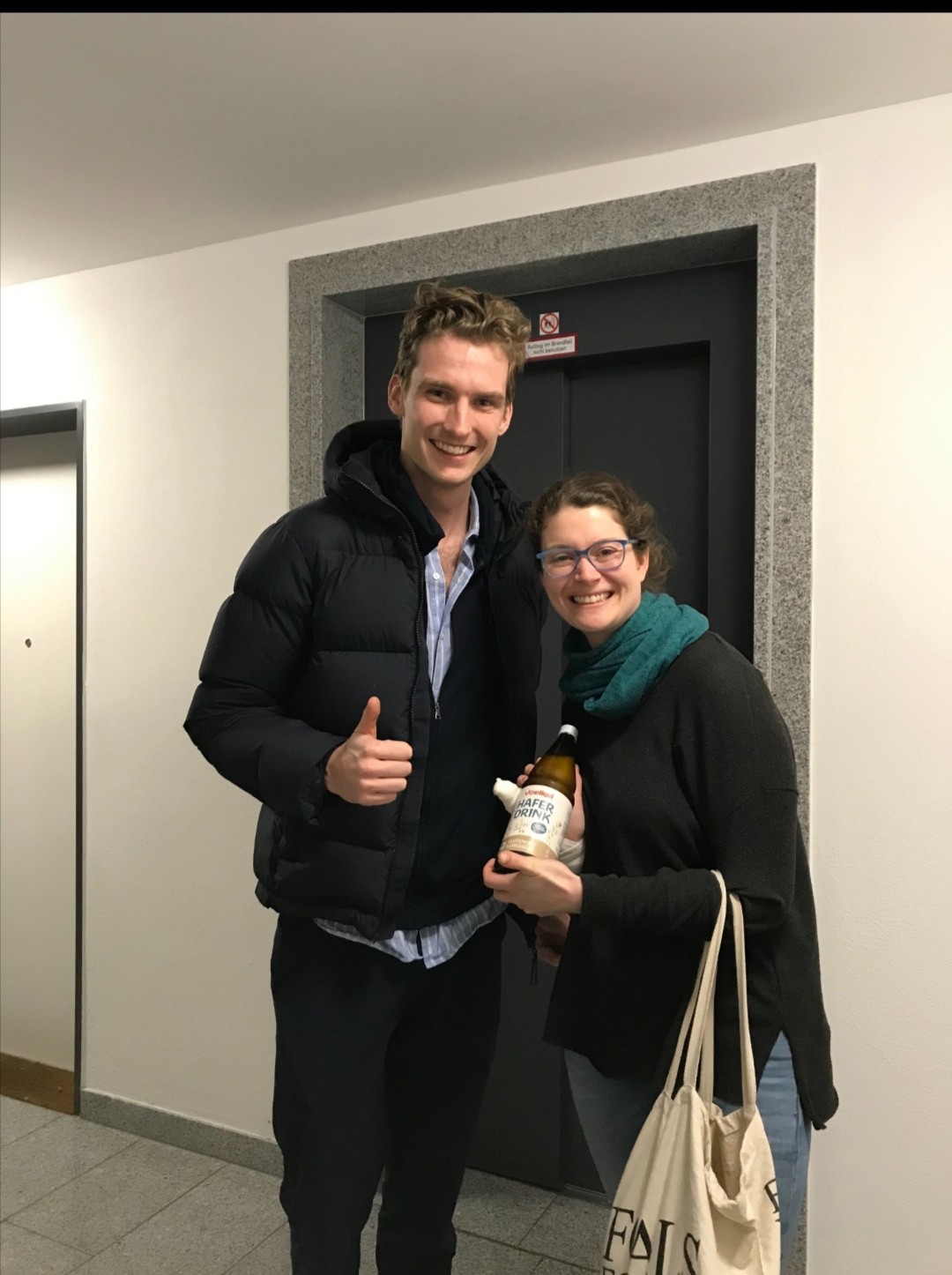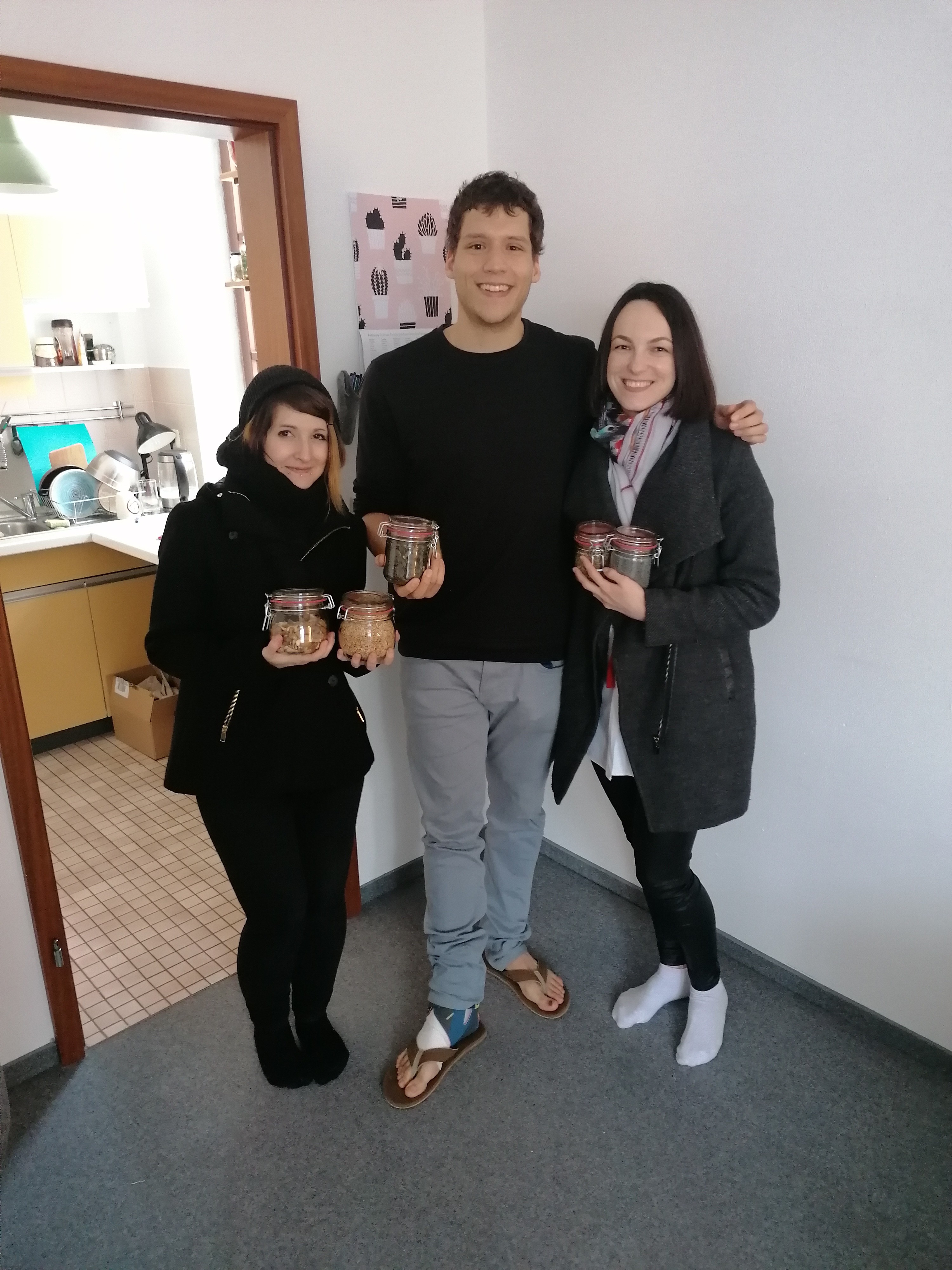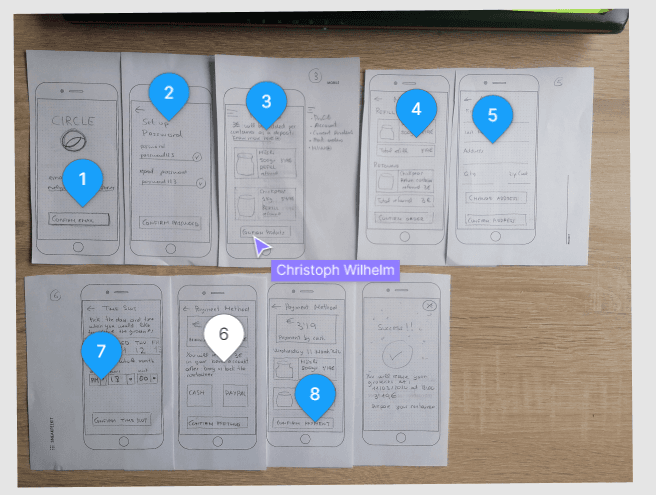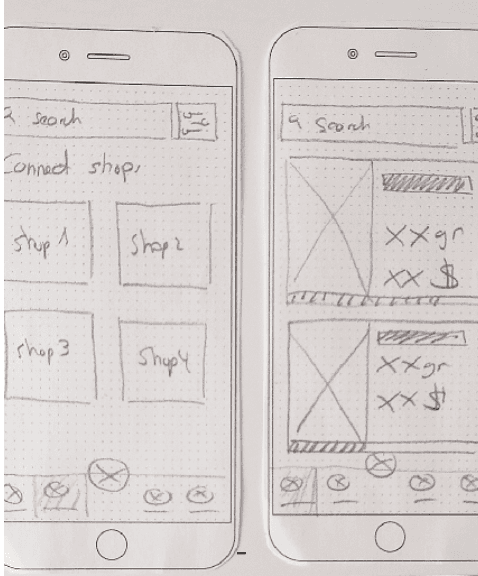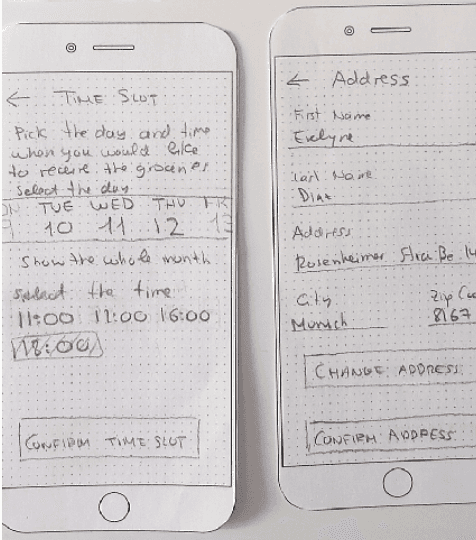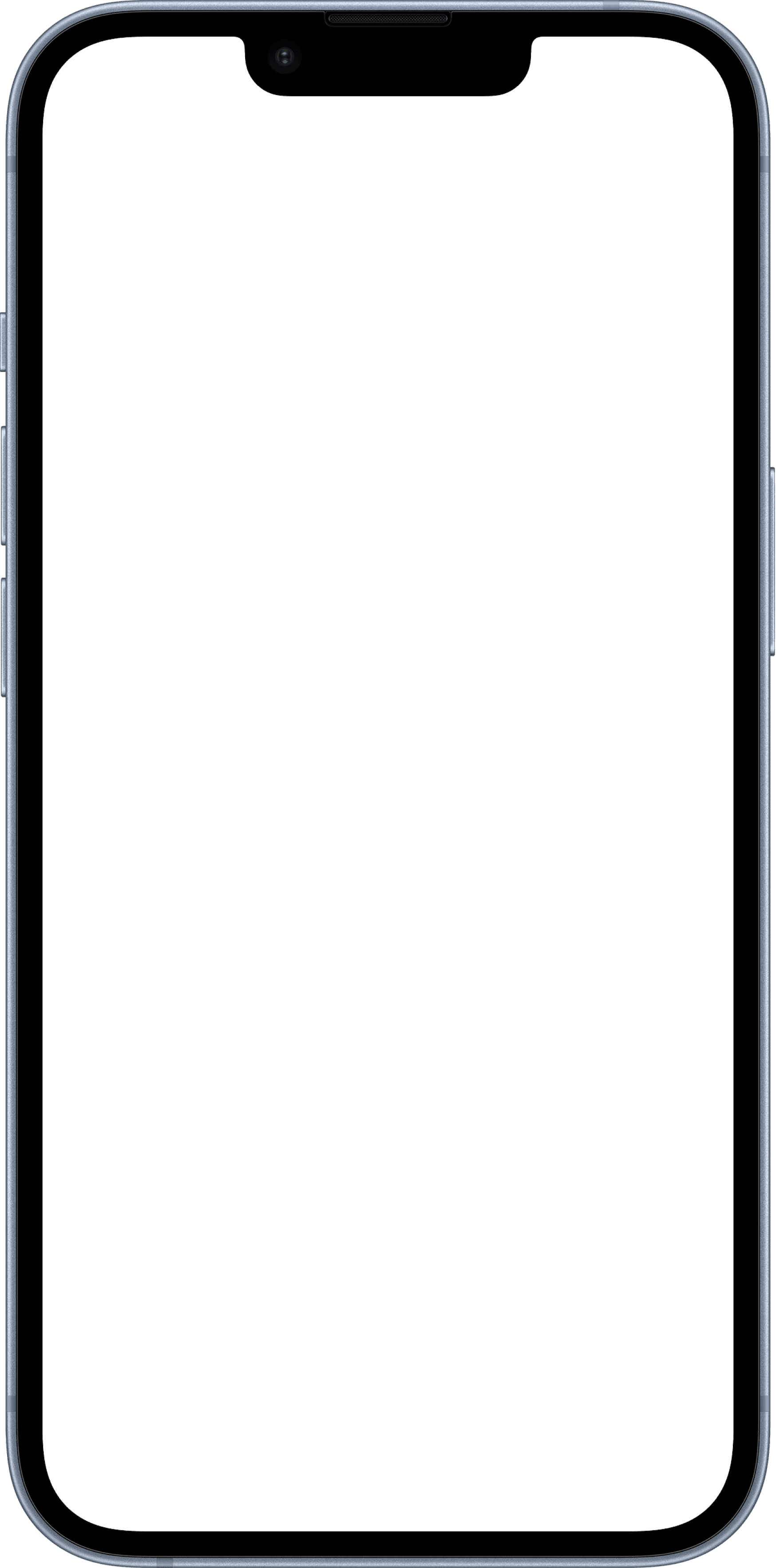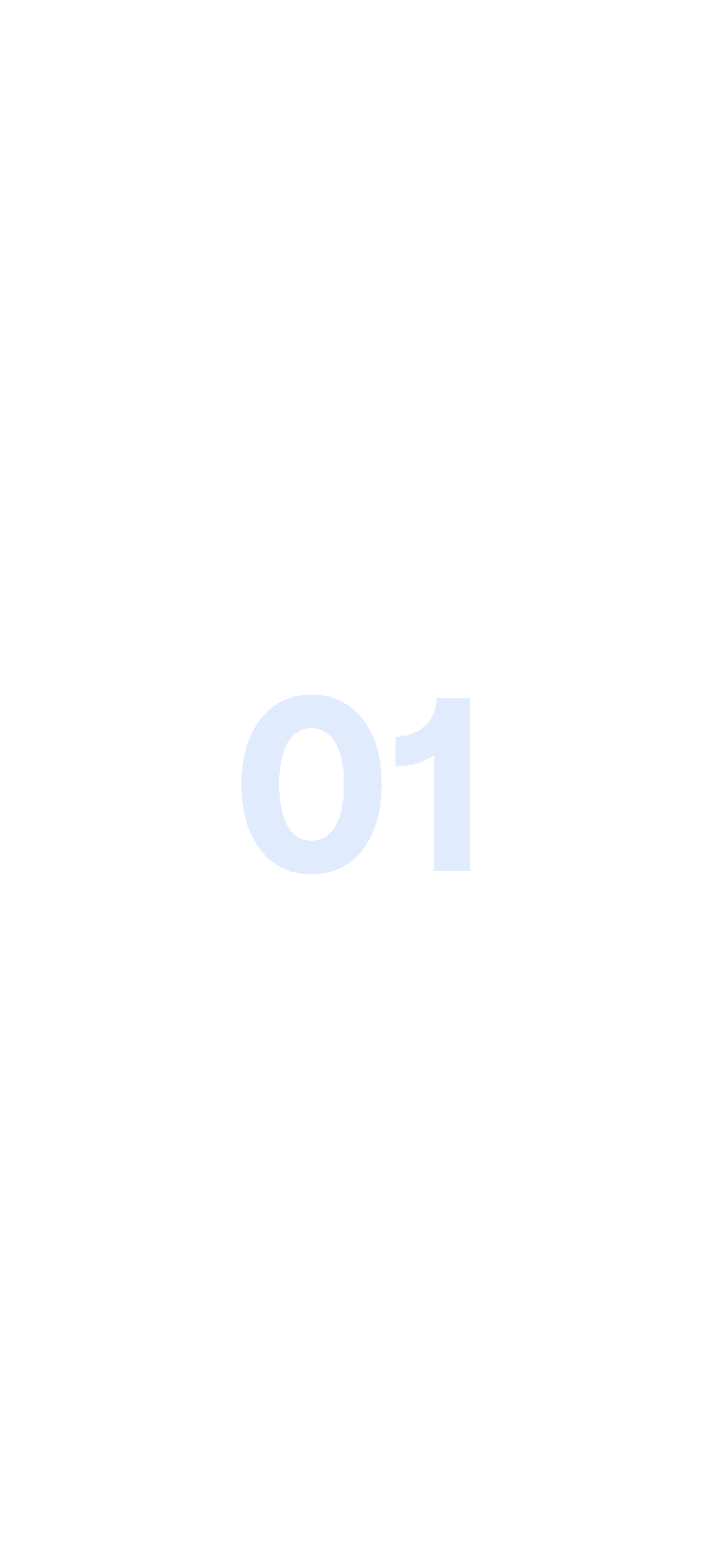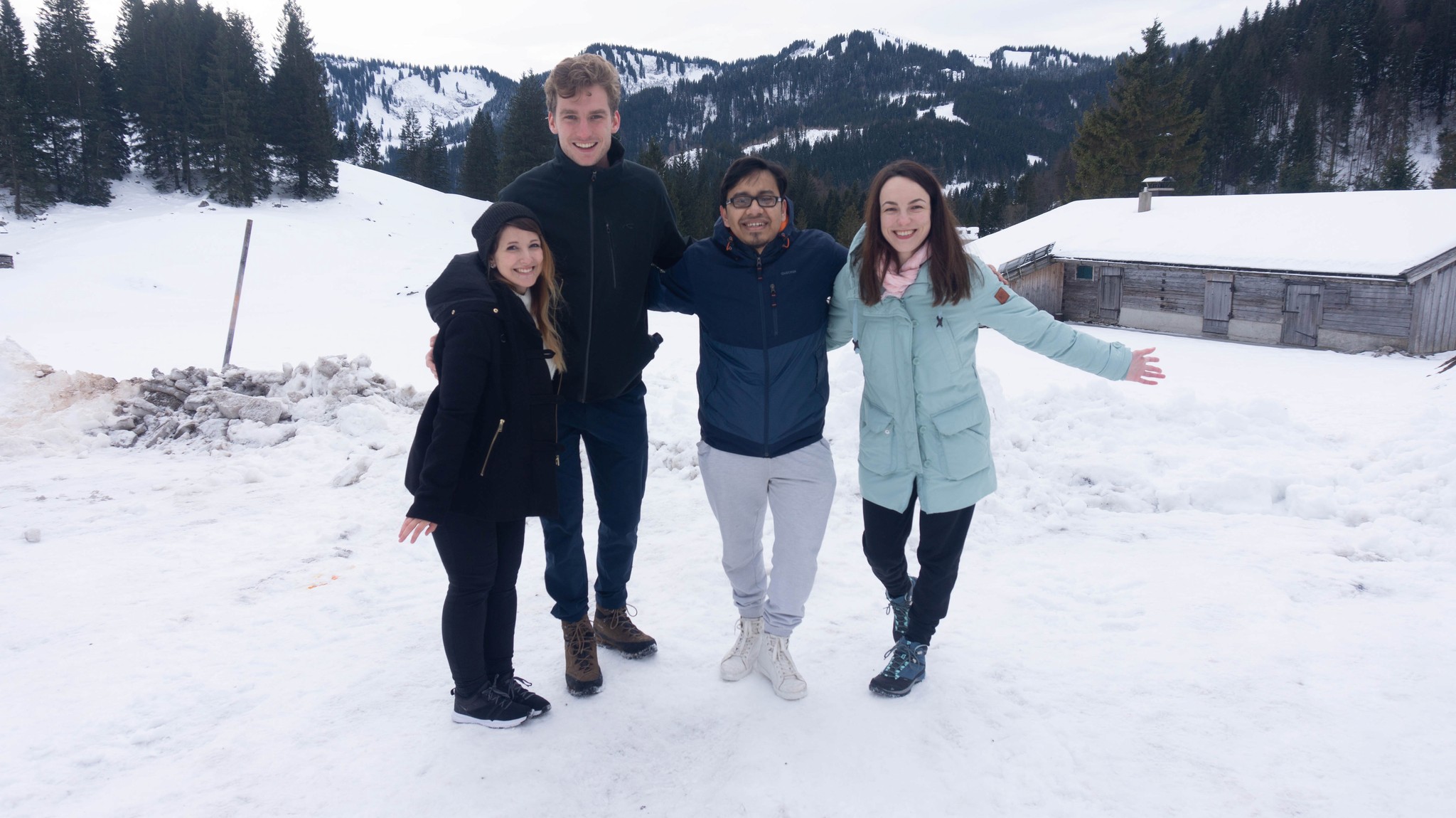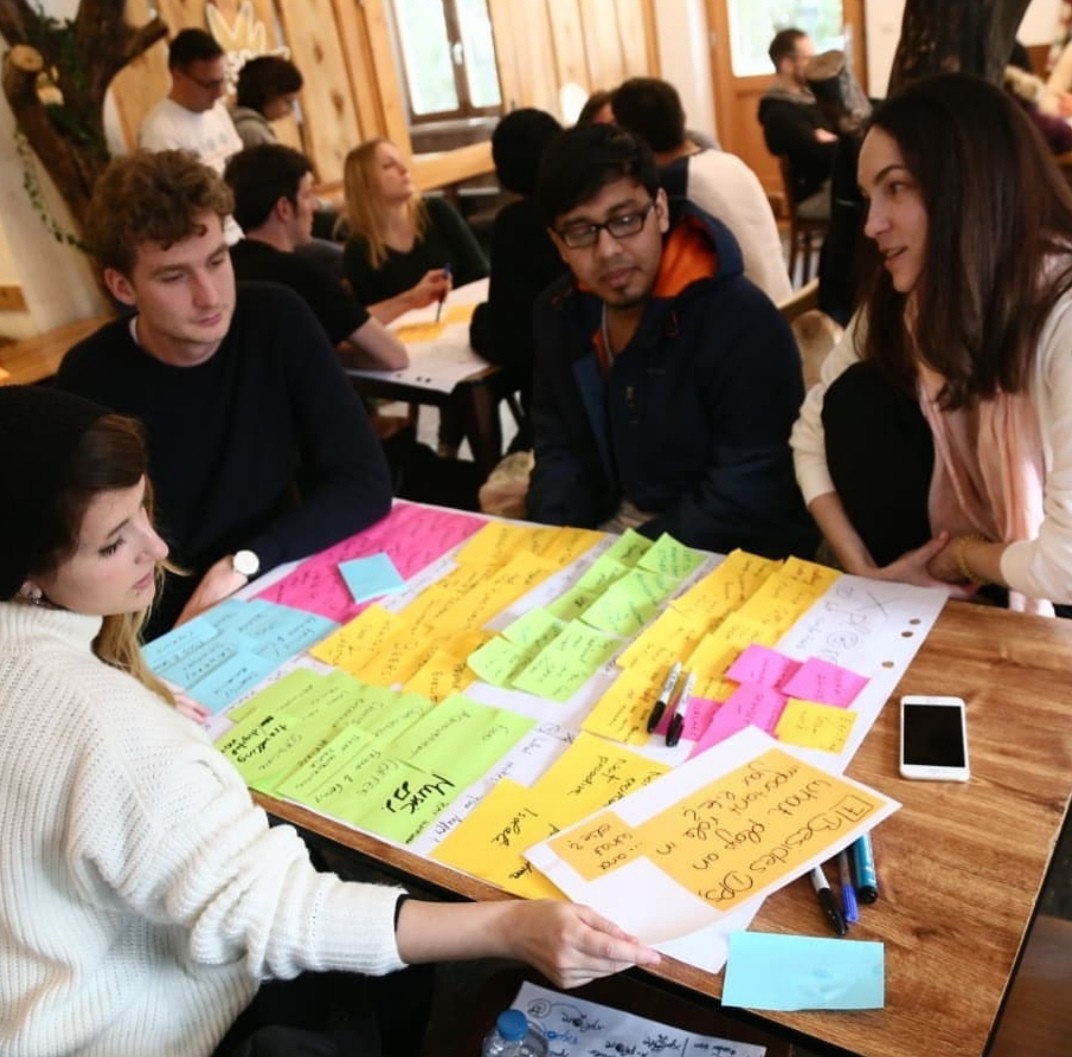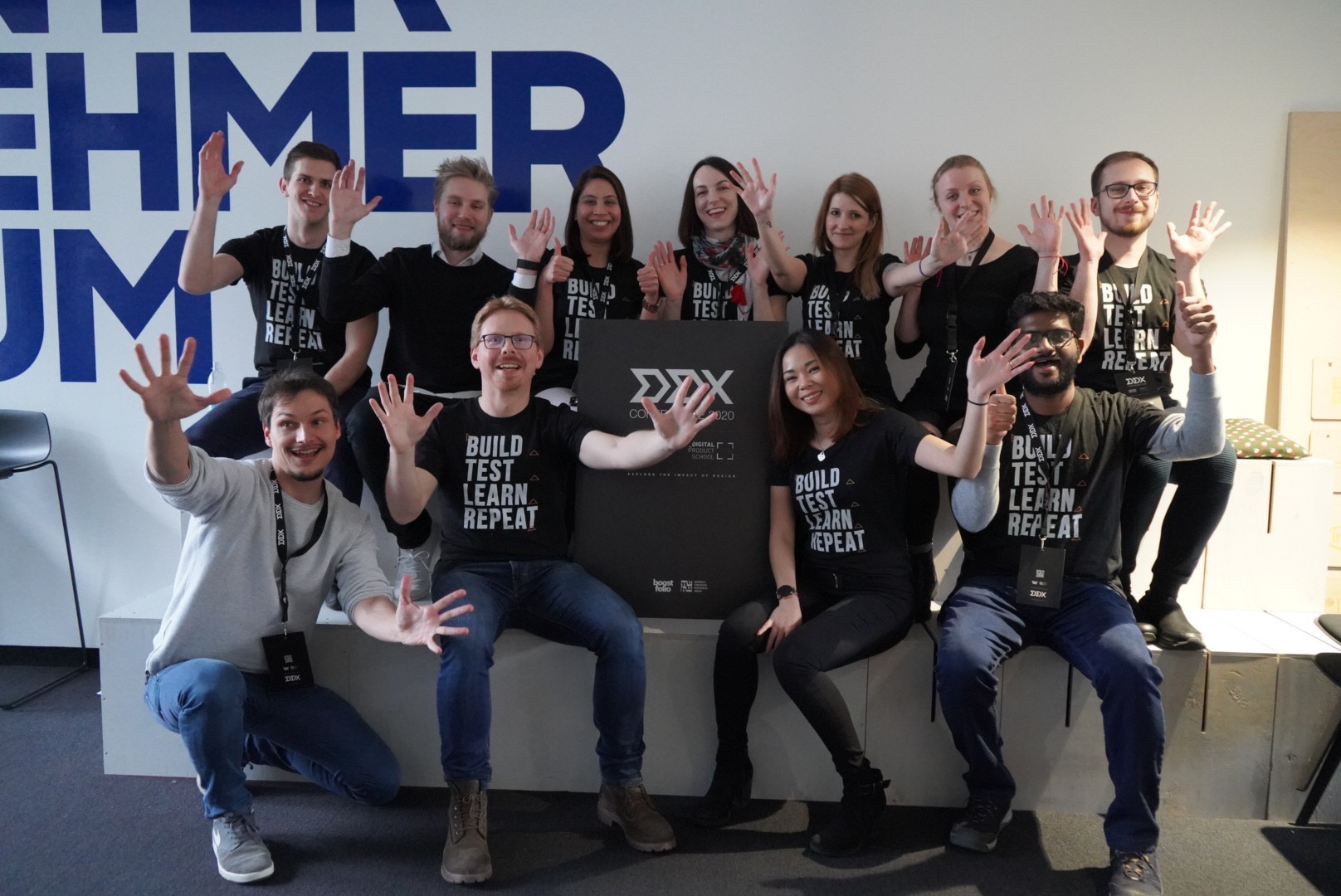Sustainable Convenience
Overview
ROLE
UX UI Designer
Main Tools USed
Figma
timeline
3 Months
INDUSTRY
Retail / Sustainable
Bootcamp Background
I have been selected as an interaction designer for the Digital Product School program. This intensive boot camp involves collaborating with international designers, engineers, and project managers to develop a product addressing a current issue in Munich.
Bootcamp Challange
What issues can we address to make a positive impact right now?
Creating a solution for a current problem in Munich was an expansive topic. We had to brainstorm different themes as a team and vote for the one everyone would feel comfortable working on for 3 months.
Project Background
The zero-waste lifestyle market is experiencing significant growth, with an increasing number of people seeking sustainable options for their everyday essentials. However, this surge in eco-friendly products can be overwhelming for shoppers trying to refill while combining them with their work, kindergarten, school schedule, etcetera.
CIRCLE aims to differentiate itself by enhancing the sustainable shopping experience. This app not only connects your current product purchases in your favorite stores but also helps you refill your pantry with your existing products without needing to travel to different stores with your containers.
Project Challange
How might we make a zero-waste lifestyle accessible and convenient?
After deciding on a zero-waste lifestyle and conducting interviews, the challenge becomes more specific. How might we make zero-waste shops accessible and convenient for everyone?
Project goals
Create a mobile app that bridges the gap between eco-consciousness and modern convenience. It offers plastic-free delivery and an easy refill service, making sustainable products accessible and convenient for all.
The Process
Empathize
Define

Test idea & Ideate

Design

Next steps
Empathize — Exploring people's needs
Overview
Research approach
Secondary Research
Assumptions Map
Interviews
Research approach
To understand the challenges faced by those living a zero-waste lifestyle, I conducted secondary research, visited zero-waste shops to observe grocery purchasing habits, and interviewed customers to validate my findings.
The goals for my research process:
Explore and identify patterns of how people buy and refill their pantry.
Identify pain points and unmet needs that people face when purchasing zero-waste products.
How did I collect all this information?
Investigations in forums and Facebook groups.
Interviewing 8+ people when buying zero-waste products.
Going to zero waste shops to observe how people behave and interact with the environment.
— Secondary Research insights
I have gathered information from Facebook Groups, Reddit, and Zero-waste lifestyle Forums, and these were some of the pros and cons I found:
PROS
Community Engagement: People value community support for zero-waste initiatives that encourage a sense of belonging through goods exchange.
Variety of Shopping Options: Zero-packaging shops like Ohne and Original Unverpackt offer a diverse range of products.
Educational Opportunities: Local groups host workshops that teach people practical skills for reducing waste.
CONS
Cost Concerns: Adopting a zero-waste lifestyle can be financially challenging, as organic and local products often cost more than conventional options.
Inconvenience: Finding products without packaging can be time-consuming and frustrating; it is necessary to plan, commute to different shops, and bring their containers during the day.
Behavioral Changes: Transitioning to a zero-waste lifestyle involves significant changes in daily habits, which many people struggle to maintain over time.
— Assumptions Map from Secondary Research
I organized the insights into an assumptions map based on importance and evidence strength.


— Interviews and Findings
I interviewed 10 people who were shopping in different zero-waste shops. In addition to learning about how they shopped for plastic-free products, I also asked about:
Their experience shopping.
What process and planning do they go through to fill their pantry?
Their frustrations, and what factors they take into account.
"To live with minimal waste, I have to do much planning, need to carry on my containers to the shops and need a few days because they are so far away" — Amalia Perez
"There are not enough plastic-free shops. I have to take the containers to work, go to different stores, waste time doing long travels from one shop to another." — Lisa Muller
The following is a summary of their main pain points:
The time-consuming nature of refilling products.
The necessity of carrying containers throughout the day.
The need to visit multiple stores.
The requirement for planning.
Define — Peoples's Needs and Problems
Overview
Empathy Map
Persona development
Problem Statement
Analyzing peoples challanges
— Empathy maps
I created empathy maps to visualize interview insights, which underlined key patterns in users' thoughts, feelings, and actions. This improved my understanding of their needs and encouraged collaboration among team members.
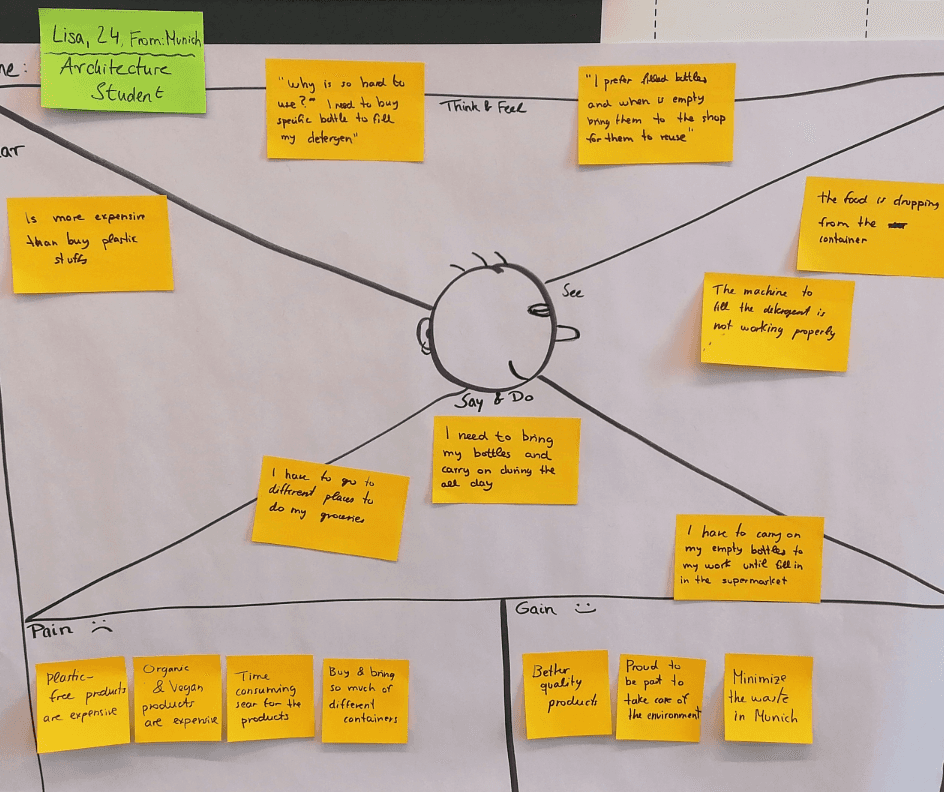
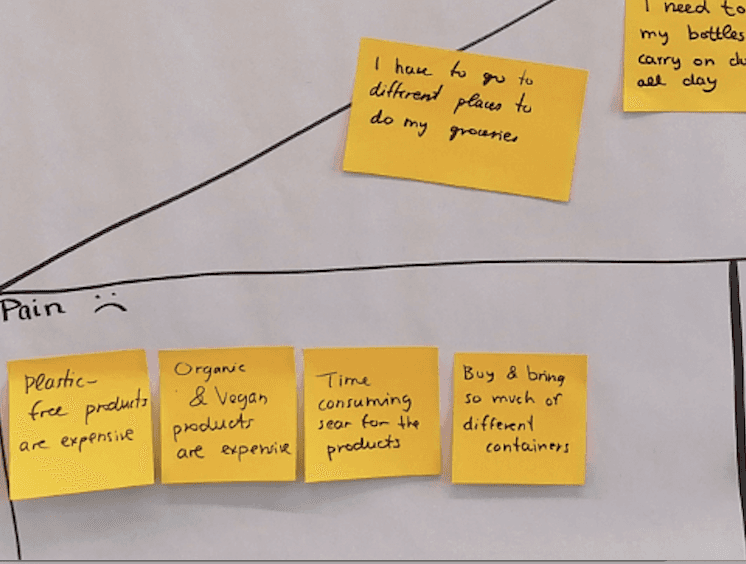
Main Insights
I have to go to different stores to refill my pantry.
It is time-consuming to get all the products I need.
I need to plan to bring which containers to which shop and combine them with my work schedule.
— Persona development
In my research, I noticed patterns among people dedicated to a zero-waste lifestyle. Many struggle with the inconvenience of commuting to different shops with their containers. However, those who have been practicing this lifestyle for a while often plan their store trips around work schedules and weekly needs. This observation inspired me to create the persona Lisa Muller.

Lisa didn’t always embrace a zero-waste lifestyle. At first, she found it overwhelming and often chose convenience over sustainability. As she explored eco-friendly options, she realized that refilling her pantry was challenging due to her busy work schedule. Frustrated, Lisa began researching local zero-packaging stores and developed a shopping plan to balance her commitment to sustainability with her daily life.
— Problem statement
How might we help Lisa effectively balance her busy work schedule with her commitment to a zero-waste lifestyle, making it easier for her to refill her pantry with sustainable products?
Test idea — Work on potential solutions
Overview
Brainstorming
Winning Idea
Testing idea
Learnings
Validate solutions with people
— 30 minute brainstorming session
After identifying that carrying containers and balancing visits to different shops with a busy work schedule were the main concerns, we, as a team, began brainstorming potential solutions. We wrote down all our ideas on sticky notes, capturing whatever came to mind.
Main ideas collected
A shopping planner to organize trips to different shops.
Collaborate with local retailers to provide real-time inventory updates and promotions.
Provide a delivery refill service.
Centralize the different zero-waste stores in one app.


After the 30-minute session, we decided to vote on the ideas that could help Lisa fill her pantry most efficiently.
— Winning Idea
Design an app that connects peoples' current purchases from their favorite zero-waste shops and also offers refill and refund delivery services for those current purchases.
This app would enable consumers to track their purchases, receive refill notifications, and conveniently have refills delivered to their door while allowing them to return their empty containers for refunds and future refills.
This solution simplifies shopping and promotes sustainable practices for a zero-waste lifestyle, but we decided to test it with real people before starting to design it.
— Testing the idea
We set up a landing page to introduce our solution to simplify the refilling process. The goal of this landing page is to collect people's emails so they can participate in the test and we can contact them further in the future.
How did the test work?
People had access to the landing page via Facebook groups and subscribed using their email.
We sent them a product order form, and they placed their orders and scheduled the time and location of the delivery.
On the day of delivery, we bought their products, brought them to their location, and conducted an interview to explain the refill service.
45%
People who subscribe to our project make a purchase and become our real consumers.
40 u.
We sold 40 products, including nuts, rice, and detergent, to people and offices.
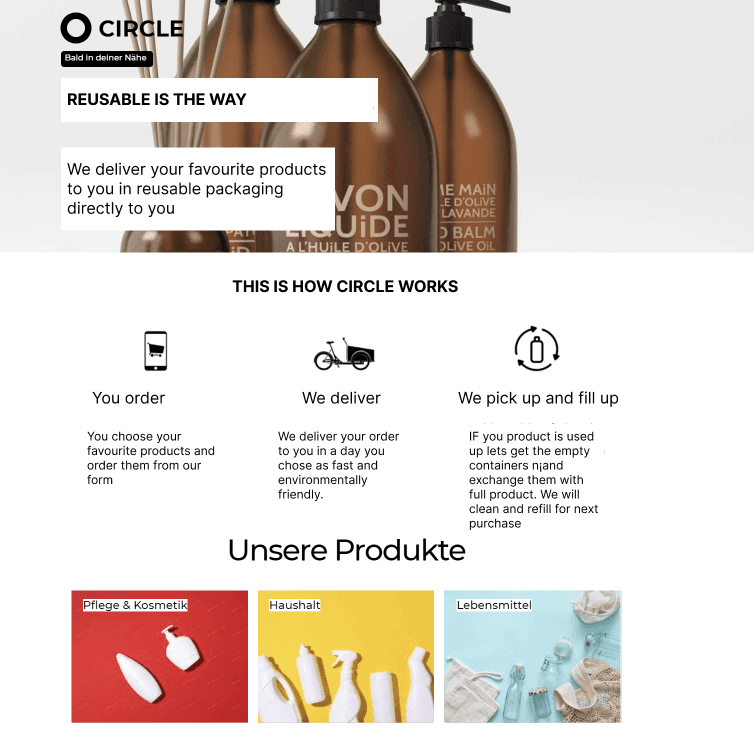

— Learnings
People are willing to embrace reusable plastic alternatives when plastic-free options are unavailable.
By combining our delivery service with a refilling solution, we offered a cost-effective alternative to traditional shopping methods.
People expressed their satisfaction with our service's time-saving aspect, as it alleviated the burden of traveling long distances to various shops for their zero-waste needs.
Ideate — Lets start with the content
Overview
MVP requirements
Site map
User Flow
Understanding the journey
— Prioritising features for the refill service app
After validating our solution through user testing, we developed a product requirements document to prioritize essential features for our Minimum Viable Product (MVP). This strategic approach ensured our initial offering would uniquely address the core needs of our target audience.
While building the main futures for the MVP, it was essential to study current apps like Zero Waste Store, Go Waste Zero, and others.
Zero Waste Store offers:
A wide range of low-waste products, ensuring plastic-free and carbon-neutral delivery service.
People can create wish lists to track desired products for future purchases.
Offers app-only discounts and rewards, incentivizing continued use and engagement.
Go Waste Zero offers:
A map that helps users find nearby stores offering plastic-free products.
People can participate in challenges to reduce waste, promoting engagement and community involvement.
Encourages people to suggest local stores, enhancing the app's community aspect.
This information helped me see what the competitors are doing to close the gap between eco-consumers and buying sustainable products. It also gave me ideas for future features and helped me organize them so that they would first provide more value to people.

— Site Map & User Flow
The site map helped me to organize the content and functionalities in a way that is intuitive for people.
The user flow helped us visualize step-by-step user interactions, identify potential friction points, and optimize the path for users to complete specific tasks seamlessly.
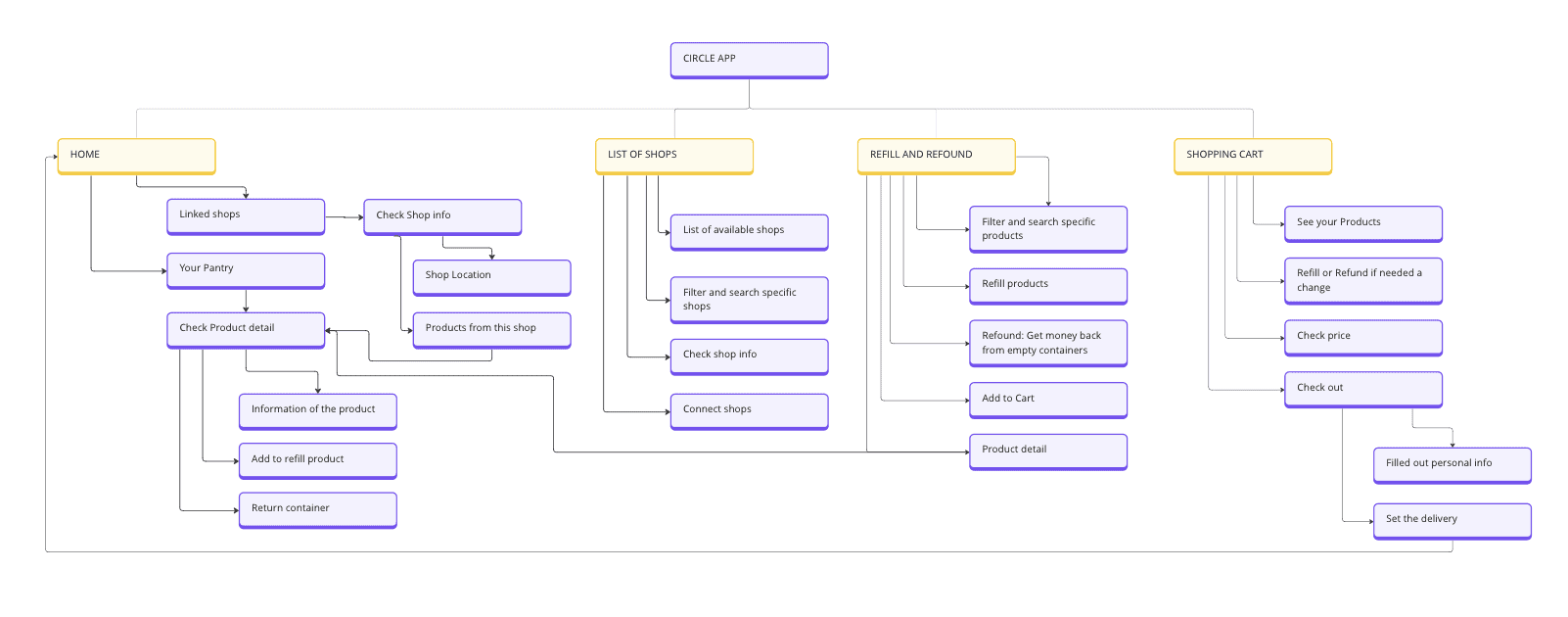
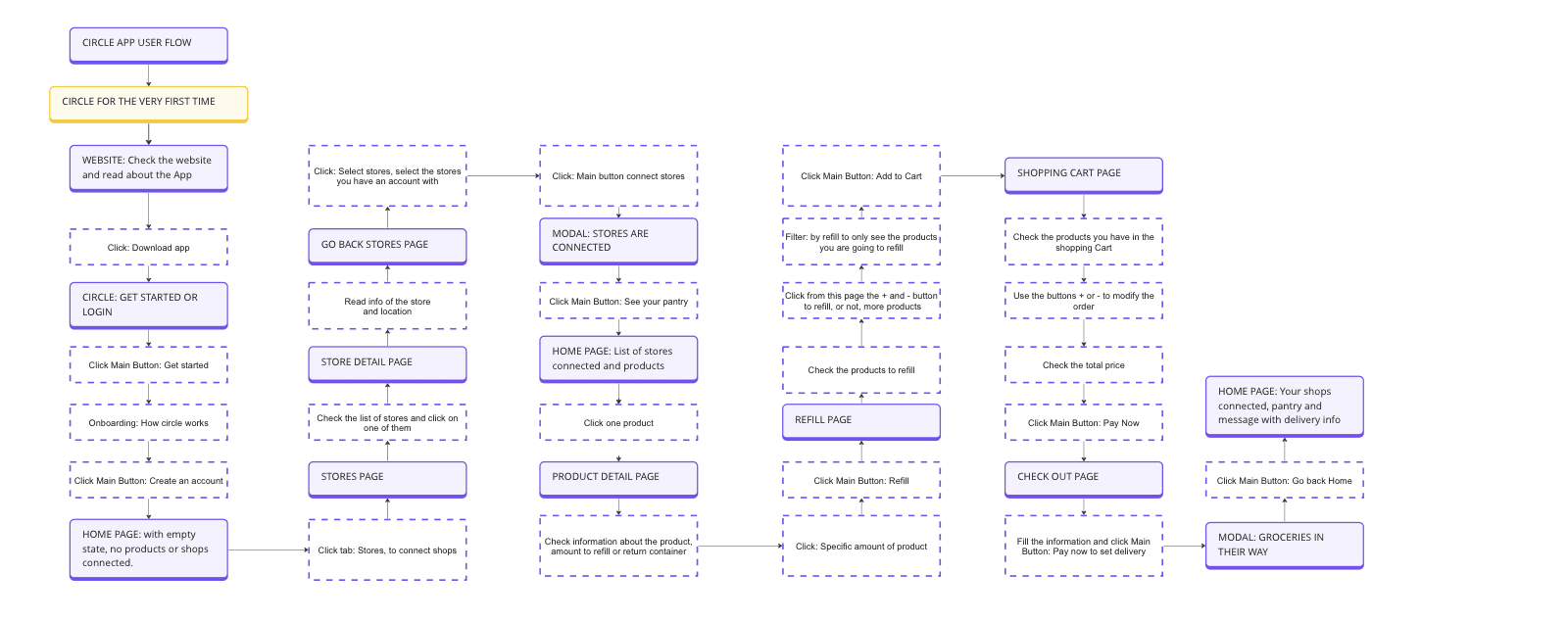
Prototype — Let's craft the solution
Overview
Sketching
MVP Mid- Wireframing
UI Style Guideline
MVP High-Fi Prototype
From sketching to prototyping
— Start designing with sketches
I started with paper and pencil first, which allowed me for easy and rapid iteration while keeping in mind the core MVP features I worked on earlier.
I utilized the Crazy 8 exercises to extract the ideas that had been forming in my head since the research phase.
(Each crazy 8 brainstorming session entailed 5-minute intervals of potentially 8 sketches with an intentional break of 20-30 minutes. Although there were times I could not come up with 8 sketches, this exercise forced me to squeeze out ideas that I needed clarification on.)
Then, I transitioned to Figma for better team collaboration, centralized comments, design changes, and decision tracking in one place.
— Wireframes
While building out the wireframes, it was essential to refer to our competitor's study for design patterns that current zero-waste customers are familiar with. I also checked more ideas using Mobbin.Design a website where you can see mobile and desktop user flows and wireframes of different to get an idea of current design patterns that are already working.
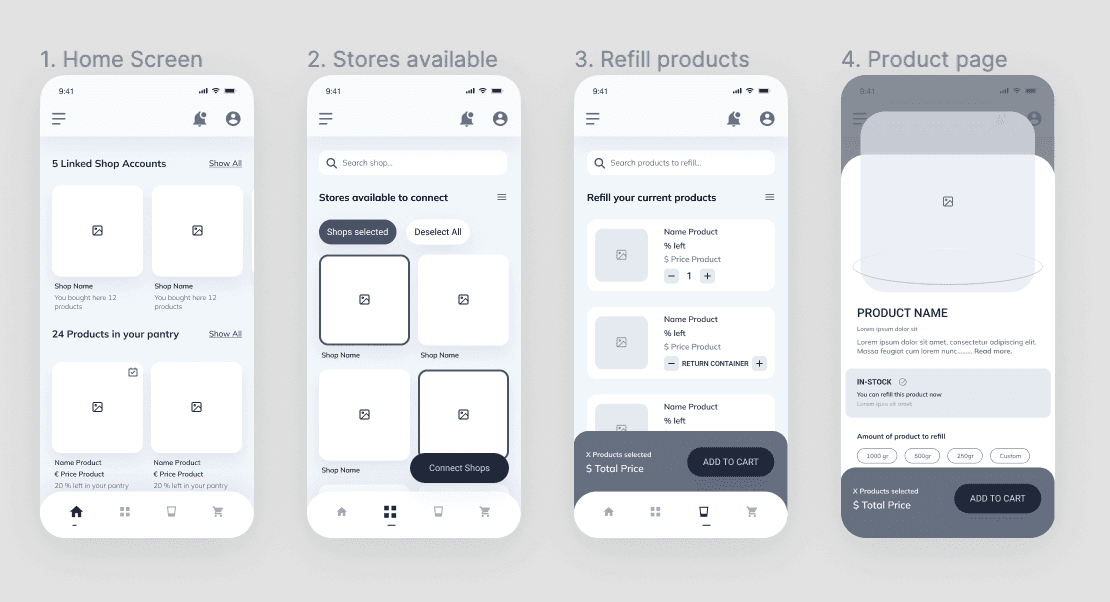
— UI Style Guideline
A basic style guide to create our branding with the goal of:
Speeding up the design process.
Achieving consistency.
Learning and mastering UI Design skills.
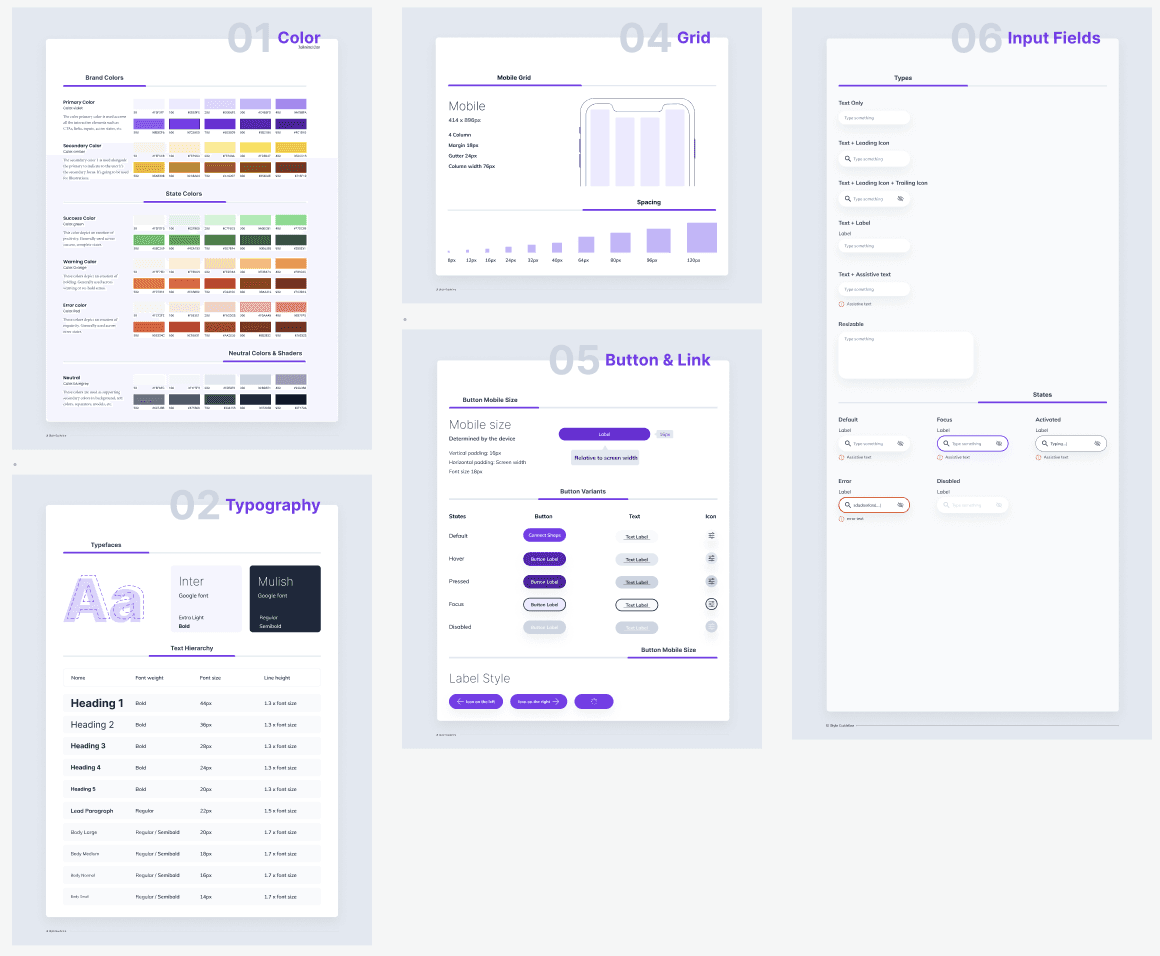
End Design — Finish MVP & Next steps
Overview
Onboarding
Connect Stores
Check Products & Shops
Refill process & Checkout
Next steps
Learnings
End Design Screens
— Onboarding
With these onboarding screens, I want to facilitate a seamless and engaging introduction for new people to the refilling and refund delivery service. The app aims to educate users about key features and enhance their understanding of the platform.
— Connect Stores
CIRCLE will link users' zero-waste shop accounts, allowing them to refill purchased products through CIRCLE app. For new product purchases, users should shop via their zero-waste website or store, and the app will automatically update for future refills.
How it works?
Go to stores, as the empty state indicate.
Select the stores you have an account with.
Click "Connect Stores" button, and your products will appear in the home page or pantry.
— Check products & Shops
The home page will display the shops people have connected to and the products they currently have in their pantry.
How it works?
On the homepage, people can see the shops they have connected to and the products they have from those shops.
Clicking on a shop opens a modal with a brief description, a button to visit the shop's website, a list of purchased products, and a clickable address for Google Maps.
Clicking on a product provides its description, availability, and size options. If users no longer want the product, they can click "Return Container," and we'll collect it on delivery day for cleaning and reuse.
— Refill Process & Check out
The refill tap will show you all the products people have in their pantry and all the containers they are using. Here, people can refill the same size or amount of product they are already using.
How it works?
In the refill tab, users can search for specific products or filter by product and container. They can only add the same product size to their cart, making reordering quick and easy with just a few clicks.
Once the order is done, they can click on the checkout button in their shipping cart.
People can choose where to have their orders delivered, adding any place, day, time of delivery, and payment method they want.
Next steps & Learnings
— What would be next?
Due to COVID-19, we had to return to our countries before border closures, and for that reason, we couldn't continue the project. But the desire following steps would be:
Next steps?
Conduct usability testing with the prototype to evaluate the UI design's effectiveness and gather insights from real users.
Based on the user testing feedback, we would iterate on how to address any usability issues and make improvements.
Once the UI design is finalized, after a few interactions and tests, we will document it and hand it off to the development team for implementation.
— Learnings!
Work and communicate with a multicultural and multidisciplinary team
More learnings
Immersing myself in an interdisciplinary team taught me to communicate daily through stand-ups and meetings so that everyone was on the same page.
Every Friday, I had to prepare a presentation about our project findings in front of other stakeholders; this practice improved my storytelling skills.
Working with other designers has its pros and cons; we engage in open-minded communication and support each other throughout the process.





